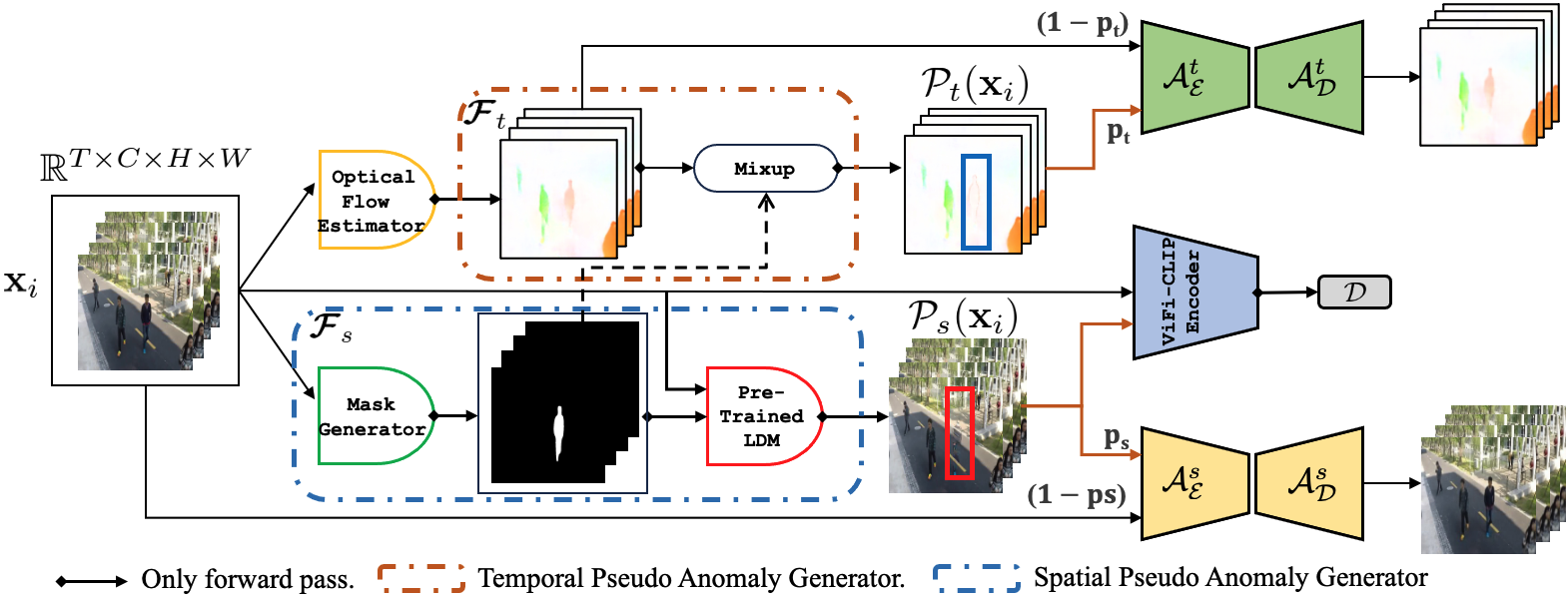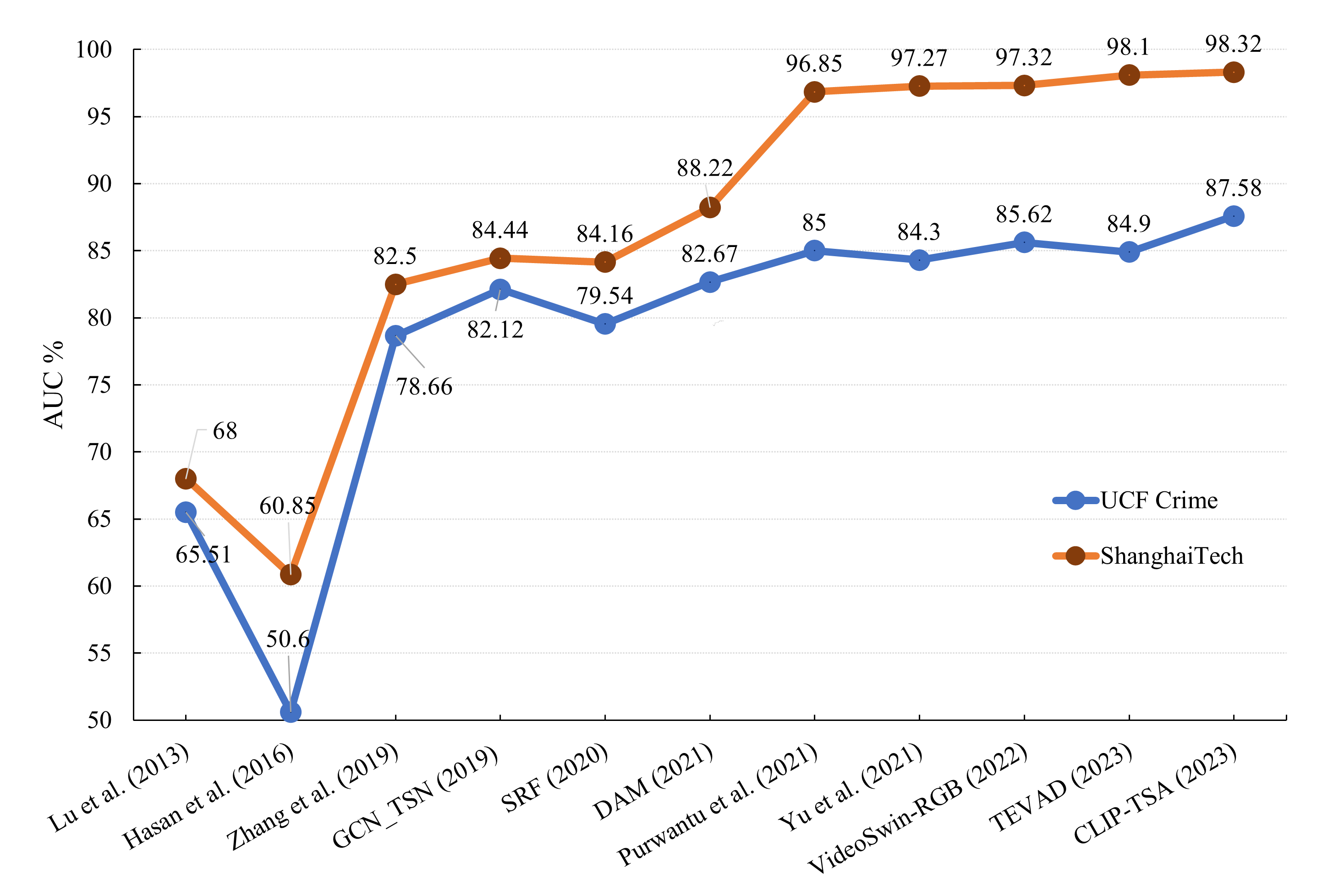An Exploratory Study on Human-Centric Video Anomaly Detection through Variational Autoencoders and Trajectory Prediction
2406.15395

0
0

Abstract
Video Anomaly Detection (VAD) represents a challenging and prominent research task within computer vision. In recent years, Pose-based Video Anomaly Detection (PAD) has drawn considerable attention from the research community due to several inherent advantages over pixel-based approaches despite the occasional suboptimal performance. Specifically, PAD is characterized by reduced computational complexity, intrinsic privacy preservation, and the mitigation of concerns related to discrimination and bias against specific demographic groups. This paper introduces TSGAD, a novel human-centric Two-Stream Graph-Improved Anomaly Detection leveraging Variational Autoencoders (VAEs) and trajectory prediction. TSGAD aims to explore the possibility of utilizing VAEs as a new approach for pose-based human-centric VAD alongside the benefits of trajectory prediction. We demonstrate TSGAD's effectiveness through comprehensive experimentation on benchmark datasets. TSGAD demonstrates comparable results with state-of-the-art methods showcasing the potential of adopting variational autoencoders. This suggests a promising direction for future research endeavors. The code base for this work is available at https://github.com/TeCSAR-UNCC/TSGAD.
Create account to get full access
Overview
- This paper explores a human-centric approach to video anomaly detection using variational autoencoders and trajectory prediction.
- The researchers propose a framework that combines unsupervised anomaly detection with human trajectory modeling to identify unusual events in video surveillance data.
- The goal is to develop a system that can effectively detect anomalies while also providing interpretable insights into the observed behaviors.
Plain English Explanation
Video anomaly detection is an important task in surveillance systems, as it can help identify potential security threats or safety issues. However, traditional approaches to anomaly detection can be opaque, making it difficult to understand why certain events are flagged as anomalous.
This paper explores an alternative approach that aims to make the detection process more transparent and user-friendly. The researchers use a type of neural network called a variational autoencoder to learn a compressed representation of normal activity in a video. By comparing new video frames to this learned representation, the system can identify when something unusual is happening.
But the key innovation is the addition of a trajectory prediction model. This component analyzes the movement patterns of people in the video and can identify when someone is behaving in a way that deviates from the typical trajectories. By combining these two techniques, the researchers hope to create a more human-centric video anomaly detection system that not only detects anomalies, but also provides insights into why certain events are considered unusual.
This approach could be particularly useful in real-world surveillance applications, where human operators need to quickly understand and respond to potential threats. By making the detection process more interpretable, the system could help these operators make more informed decisions.
Technical Explanation
The proposed framework consists of two main components: a variational autoencoder (VAE) for unsupervised anomaly detection, and a trajectory prediction model for incorporating human-centric information.
The VAE is trained on normal video frames to learn a compressed representation of typical activity. This learned representation is then used to detect anomalies by measuring the reconstruction error when new frames are passed through the network. Frames with high reconstruction error are flagged as potentially anomalous.
To provide more context around these anomalies, the researchers also incorporate a trajectory prediction model. This model analyzes the movement patterns of people in the video and uses a statistical test to identify when someone is behaving in an unusual way compared to the predicted trajectories.
By combining the anomaly detection from the VAE with the trajectory analysis, the proposed framework aims to provide a more holistic and explainable video anomaly detection system. The researchers evaluate their approach on several benchmark datasets and demonstrate its effectiveness in identifying anomalous events while also providing insights into the underlying human behaviors.
Critical Analysis
The paper presents a promising approach to video anomaly detection that leverages both unsupervised learning and human-centric trajectory modeling. The combination of these two techniques could lead to a more interpretable and user-friendly system, which is an important consideration for real-world surveillance applications.
However, the paper does not address several potential limitations of the proposed framework. For example, the trajectory prediction model may struggle to accurately capture complex or unusual movement patterns, which could lead to false positives or missed anomalies. Additionally, the reliance on a VAE for anomaly detection may be sensitive to the quality and diversity of the training data, which could limit the system's generalization capabilities.
Further research is needed to explore the robustness and scalability of this approach, as well as to investigate potential biases or ethical concerns that may arise from the use of such a system in sensitive domains. Integrating additional explainability techniques could also help to provide users with a deeper understanding of the system's decision-making process.
Conclusion
This paper presents an innovative approach to video anomaly detection that combines unsupervised learning and human-centric trajectory modeling. By providing both anomaly detection and insights into the underlying behaviors, the proposed framework aims to create a more interpretable and user-friendly surveillance system.
While the technical details of the approach are promising, further research is needed to address potential limitations and explore the broader implications of deploying such a system in real-world settings. Nonetheless, this work represents an important step towards developing more transparent and accountable video anomaly detection technologies.
This summary was produced with help from an AI and may contain inaccuracies - check out the links to read the original source documents!
Related Papers

Video Anomaly Detection via Spatio-Temporal Pseudo-Anomaly Generation : A Unified Approach
Ayush K. Rai, Tarun Krishna, Feiyan Hu, Alexandru Drimbarean, Kevin McGuinness, Alan F. Smeaton, Noel E. O'Connor

0
0
Video Anomaly Detection (VAD) is an open-set recognition task, which is usually formulated as a one-class classification (OCC) problem, where training data is comprised of videos with normal instances while test data contains both normal and anomalous instances. Recent works have investigated the creation of pseudo-anomalies (PAs) using only the normal data and making strong assumptions about real-world anomalies with regards to abnormality of objects and speed of motion to inject prior information about anomalies in an autoencoder (AE) based reconstruction model during training. This work proposes a novel method for generating generic spatio-temporal PAs by inpainting a masked out region of an image using a pre-trained Latent Diffusion Model and further perturbing the optical flow using mixup to emulate spatio-temporal distortions in the data. In addition, we present a simple unified framework to detect real-world anomalies under the OCC setting by learning three types of anomaly indicators, namely reconstruction quality, temporal irregularity and semantic inconsistency. Extensive experiments on four VAD benchmark datasets namely Ped2, Avenue, ShanghaiTech and UBnormal demonstrate that our method performs on par with other existing state-of-the-art PAs generation and reconstruction based methods under the OCC setting. Our analysis also examines the transferability and generalisation of PAs across these datasets, offering valuable insights by identifying real-world anomalies through PAs.
4/9/2024

Hybrid Video Anomaly Detection for Anomalous Scenarios in Autonomous Driving
Daniel Bogdoll, Jan Imhof, Tim Joseph, J. Marius Zollner

0
0
In autonomous driving, the most challenging scenarios are the ones that can only be detected within their temporal context. Most video anomaly detection approaches focus either on surveillance or traffic accidents, which are only a subfield of autonomous driving. In this work, we present HF$^2$-VAD$_{AD}$, a variation of the HF$^2$-VAD surveillance video anomaly detection method for autonomous driving. We learn a representation of normality from a vehicle's ego perspective and evaluate pixel-wise anomaly detections in rare and critical scenarios.
6/11/2024

Video Anomaly Detection in 10 Years: A Survey and Outlook
Moshira Abdalla, Sajid Javed, Muaz Al Radi, Anwaar Ulhaq, Naoufel Werghi

0
0
Video anomaly detection (VAD) holds immense importance across diverse domains such as surveillance, healthcare, and environmental monitoring. While numerous surveys focus on conventional VAD methods, they often lack depth in exploring specific approaches and emerging trends. This survey explores deep learning-based VAD, expanding beyond traditional supervised training paradigms to encompass emerging weakly supervised, self-supervised, and unsupervised approaches. A prominent feature of this review is the investigation of core challenges within the VAD paradigms including large-scale datasets, features extraction, learning methods, loss functions, regularization, and anomaly score prediction. Moreover, this review also investigates the vision language models (VLMs) as potent feature extractors for VAD. VLMs integrate visual data with textual descriptions or spoken language from videos, enabling a nuanced understanding of scenes crucial for anomaly detection. By addressing these challenges and proposing future research directions, this review aims to foster the development of robust and efficient VAD systems leveraging the capabilities of VLMs for enhanced anomaly detection in complex real-world scenarios. This comprehensive analysis seeks to bridge existing knowledge gaps, provide researchers with valuable insights, and contribute to shaping the future of VAD research.
7/2/2024
❗
Statistical Test for Anomaly Detections by Variational Auto-Encoders
Daiki Miwa, Tomohiro Shiraishi, Vo Nguyen Le Duy, Teruyuki Katsuoka, Ichiro Takeuchi

0
0
In this study, we consider the reliability assessment of anomaly detection (AD) using Variational Autoencoder (VAE). Over the last decade, VAE-based AD has been actively studied in various perspective, from method development to applied research. However, when the results of ADs are used in high-stakes decision-making, such as in medical diagnosis, it is necessary to ensure the reliability of the detected anomalies. In this study, we propose the VAE-AD Test as a method for quantifying the statistical reliability of VAE-based AD within the framework of statistical testing. Using the VAE-AD Test, the reliability of the anomaly regions detected by a VAE can be quantified in the form of p-values. This means that if an anomaly is declared when the p-value is below a certain threshold, it is possible to control the probability of false detection to a desired level. Since the VAE-AD Test is constructed based on a new statistical inference framework called selective inference, its validity is theoretically guaranteed in finite samples. To demonstrate the validity and effectiveness of the proposed VAE-AD Test, numerical experiments on artificial data and applications to brain image analysis are conducted.
6/4/2024